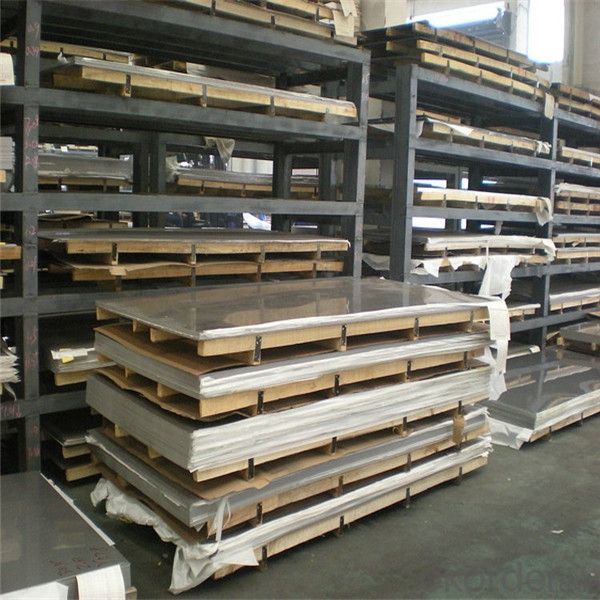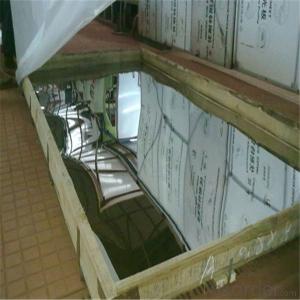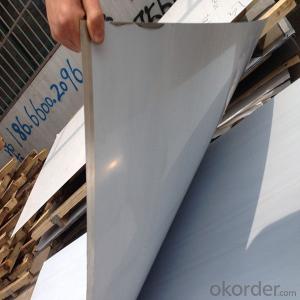Stainless Steel Coils and Sheets 201 304 316
- Loading Port:
- Shanghai
- Payment Terms:
- TT OR LC
- Min Order Qty:
- 1 m.t.
- Supply Capability:
- 3000 m.t./month
OKorder Service Pledge
OKorder Financial Service
You Might Also Like
Item specifice
Applications of Stainless Steel Coils and Sheets:
1. Automotive:Automotive trim and molding/Difficult-to-form exhaust-system components, tubular manifolds, mufflers/Exhaust manifold and other exhaust-system components, catalytic converter shells, clamps
2. Construction: Gutters and downspouts, roofing, siding
3. Kitchenware: Cooking utensils, dishwashers, ovens, range hoods, refrigerators, skewers
4. Chemical processing: Oil refinery equipment, oil burner and heater parts
5. Appliances: Hot water tanks, residential furnaces
6. Power generation: Heat Exchanger tubing
7. Farming: Dry fertilizer spreaders/Farm animal pens
Technical notes:

- Q:Are stainless steel plates 3.4mm or 3.5mm thick?
- The thickness of less than 1mm of any size 0.05mm times, thickness more than 1mm of any size 0.1mm times;According to standard GB/T 709-2006 hot rolled steel sheet size tolerances, the stainless steel sheet thickness is 3~400mm,
- Q:What are the different sizes available for stainless steel sheets?
- Stainless steel sheets are available in a wide range of sizes to cater to various applications and requirements. The most common sizes for stainless steel sheets are typically 4 feet by 8 feet (1219mm x 2438mm) and 4 feet by 10 feet (1219mm x 3048mm). These sizes are widely used in construction, architecture, and industrial settings. However, stainless steel sheets are also available in smaller sizes, such as 2 feet by 4 feet (609mm x 1219mm) or even smaller, which are commonly used for DIY projects, hobbyists, and smaller-scale applications. On the other hand, larger sizes of stainless steel sheets are also available for specific purposes. These can include sheets measuring up to 5 feet by 10 feet (1524mm x 3048mm) or even larger, which are often used in specialized industries like shipbuilding, oil and gas, or manufacturing. It is important to note that the thickness of stainless steel sheets can vary independently of their size, as different applications may require different thicknesses. Common thicknesses range from 0.025 inches (0.64mm) to 0.1875 inches (4.76mm) or even thicker for specialized applications. Overall, the availability of stainless steel sheets in various sizes allows for flexibility and customization according to the specific needs of a project, whether it be a small DIY endeavor or a large-scale industrial application.
- Q:Can stainless steel sheets be used for escalator steps?
- Yes, stainless steel sheets can be used for escalator steps. Stainless steel is a popular choice for escalator steps due to its durability, strength, and resistance to corrosion. It can withstand the constant foot traffic, heavy loads, and the wear and tear that escalator steps are subjected to on a daily basis. Additionally, stainless steel has a sleek and modern appearance, which adds to the overall aesthetic appeal of escalators. This makes stainless steel sheets a reliable and practical choice for escalator steps in various commercial and public settings.
- Q:How do you prevent crevice corrosion on stainless steel sheets?
- To prevent crevice corrosion on stainless steel sheets, there are several measures that can be taken: 1. Regular cleaning and maintenance: Keeping the stainless steel sheets clean and free from any contaminants is crucial in preventing crevice corrosion. Regular cleaning with mild detergent and water, followed by thorough rinsing and drying, helps remove any potential corrosive agents. 2. Avoiding accumulation of debris or moisture: It is important to ensure that there are no crevices or gaps where debris or moisture can accumulate. Regular inspection and maintenance can help identify and rectify any such areas. Additionally, maintaining good drainage systems and avoiding water pooling can help prevent the accumulation of moisture, which can contribute to crevice corrosion. 3. Applying protective coatings: Applying a protective coating on the stainless steel sheets can provide an additional barrier against crevice corrosion. There are various types of coatings available, such as paints, epoxy coatings, or specialized corrosion-resistant coatings specifically designed for stainless steel. 4. Using appropriate gaskets and sealants: When fastening or joining stainless steel sheets, it is important to use compatible gaskets and sealants. These should be resistant to corrosion and provide a barrier against moisture and contaminants. Silicone-based sealants or gaskets made from PTFE (polytetrafluoroethylene) are commonly used for this purpose. 5. Preventing galvanic corrosion: Galvanic corrosion can occur when dissimilar metals come into contact with each other in the presence of an electrolyte, leading to corrosion of the less noble metal. To prevent this, it is important to avoid using dissimilar metals in close proximity to stainless steel sheets. If it is necessary to use dissimilar metals, insulating materials or coatings can be used to separate them. 6. Regular inspection and maintenance: Regularly inspecting the stainless steel sheets for any signs of corrosion and addressing them promptly is essential in preventing crevice corrosion. This includes checking for any signs of pitting, discoloration, or degradation of the protective coatings. Any identified issues should be addressed immediately to prevent further corrosion. By following these preventive measures, crevice corrosion on stainless steel sheets can be effectively minimized, ensuring their longevity and maintaining their aesthetic appeal.
- Q:How do stainless steel sheets compare to other types of metal sheets?
- Stainless steel sheets have several advantages over other types of metal sheets. They are highly resistant to corrosion, making them suitable for various applications in industries such as automotive, construction, and food processing. Stainless steel sheets also offer exceptional strength and durability, ensuring long-lasting performance. Additionally, they have an attractive appearance, making them popular for aesthetic purposes. While stainless steel sheets may be slightly more expensive than other metal sheets, their numerous benefits make them a worthwhile investment.
- Q:What is the impact resistance of stainless steel sheets?
- Stainless steel sheets have high impact resistance due to their inherent strength and durability. They can withstand heavy impacts without deformation or breakage, making them suitable for various applications where resistance to impact is crucial, such as in construction, automotive, and aerospace industries.
- Q:What is the function of a stainless steel plate at the top of the steel chimney?
- According to some characteristic elements of main chemical components in steel or steel in the classification, divided into chromium stainless steel, chromium nickel stainless steel, nickel chromium molybdenum stainless steel and low carbon steel, stainless steel, stainless steel and high molybdenum high purity; according to the characteristics and application of classification of steel, stainless steel, divided into nitric acid resistant stainless steel, high resistance to sulfuric acid pitting resistance to stress corrosion of stainless steel, stainless steel, stainless steel and other steel; according to the classification features, divided into low temperature stainless steel, non-magnetic stainless steel, stainless steel, stainless steel, free cutting superplasticity.
- Q:What is the maximum width available for stainless steel sheets?
- The maximum width available for stainless steel sheets can vary depending on the manufacturer and supplier. However, in general, stainless steel sheets are commonly available in widths ranging from 36 inches (0.91 meters) to 72 inches (1.83 meters). Some manufacturers may offer even wider options for specialized applications. It is always advisable to check with the specific supplier or manufacturer for the maximum width available, as it may vary based on their production capabilities and product offerings.
- Q:What is the elongation of stainless steel sheets?
- The elongation of stainless steel sheets refers to the ability of the material to stretch or deform without breaking when subjected to tensile forces. It is expressed as a percentage of the original length of the sheet that it can be stretched before fracturing occurs. The elongation of stainless steel sheets can vary depending on the specific grade of stainless steel and its manufacturing process. Generally, stainless steel sheets have a higher elongation compared to other metals, such as carbon steel, due to their higher ductility. However, the exact elongation value can vary depending on factors such as the grade, thickness, and tempering of the stainless steel sheet.
- Q:What are the factors to consider when selecting the right grade of stainless steel sheet?
- There are several considerations to keep in mind when choosing the appropriate grade of stainless steel sheet. Firstly, it is crucial to understand the intended application of the sheet. Different grades of stainless steel offer varying levels of corrosion resistance, strength, and temperature resistance. Therefore, it is important to assess the specific requirements of the application, such as exposure to corrosive environments or high temperatures. Additionally, the desired appearance and finish of the sheet should be taken into account. Some grades of stainless steel are more suitable for achieving a polished or mirror-like finish, while others are better suited for a brushed or matte appearance. Certain grades may also be more resistant to scratching or showing fingerprints, which is important in applications where aesthetics are a priority. Cost is another significant factor to consider. Prices for different grades of stainless steel can vary significantly, depending on factors such as the alloying elements used and the manufacturing process. It is essential to strike a balance between the desired properties and performance of the sheet and the available budget. The ease of fabrication and welding is also a critical factor. Some grades of stainless steel are more easily machinable and formable, making them better suited for certain fabrication processes. Similarly, certain grades have better weldability, which is important in applications where welding is required. Lastly, the availability and sourcing of the selected grade should be considered. Certain grades of stainless steel may be more readily available in specific regions or from certain suppliers. Ensuring that the selected grade can be easily sourced is important to avoid delays or increased costs in the supply chain. In conclusion, when choosing the appropriate grade of stainless steel sheet, careful consideration should be given to factors such as the intended application, desired appearance, cost, ease of fabrication and welding, and availability. By evaluating these factors, one can make an informed decision and select the most suitable grade of stainless steel sheet for their specific requirements.
1. Manufacturer Overview |
|
|---|---|
| Location | |
| Year Established | |
| Annual Output Value | |
| Main Markets | |
| Company Certifications | |
2. Manufacturer Certificates |
|
|---|---|
| a) Certification Name | |
| Range | |
| Reference | |
| Validity Period | |
3. Manufacturer Capability |
|
|---|---|
| a)Trade Capacity | |
| Nearest Port | |
| Export Percentage | |
| No.of Employees in Trade Department | |
| Language Spoken: | |
| b)Factory Information | |
| Factory Size: | |
| No. of Production Lines | |
| Contract Manufacturing | |
| Product Price Range | |
Send your message to us
Stainless Steel Coils and Sheets 201 304 316
- Loading Port:
- Shanghai
- Payment Terms:
- TT OR LC
- Min Order Qty:
- 1 m.t.
- Supply Capability:
- 3000 m.t./month
OKorder Service Pledge
OKorder Financial Service
Similar products
New products
Hot products
Hot Searches
Related keywords





























